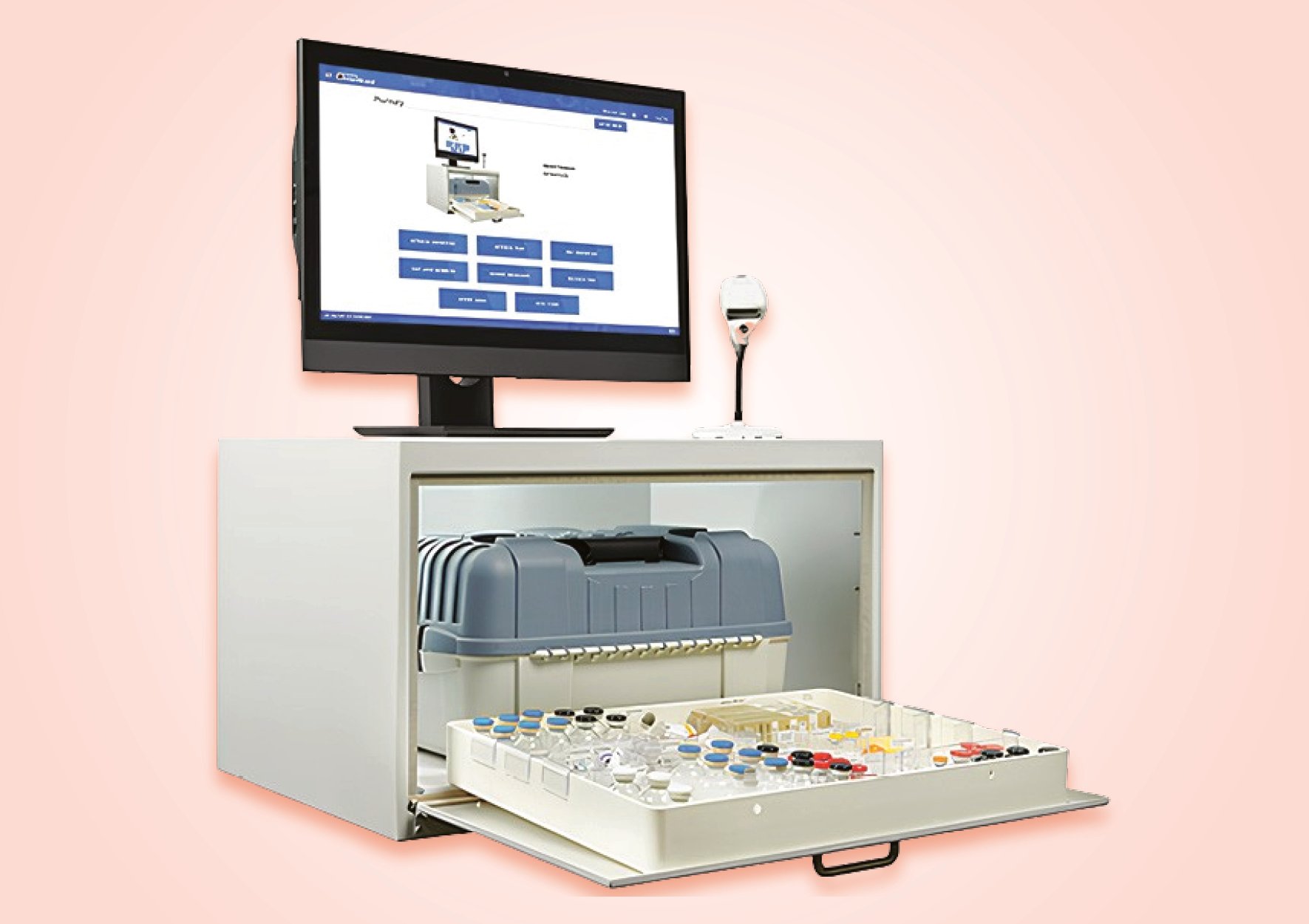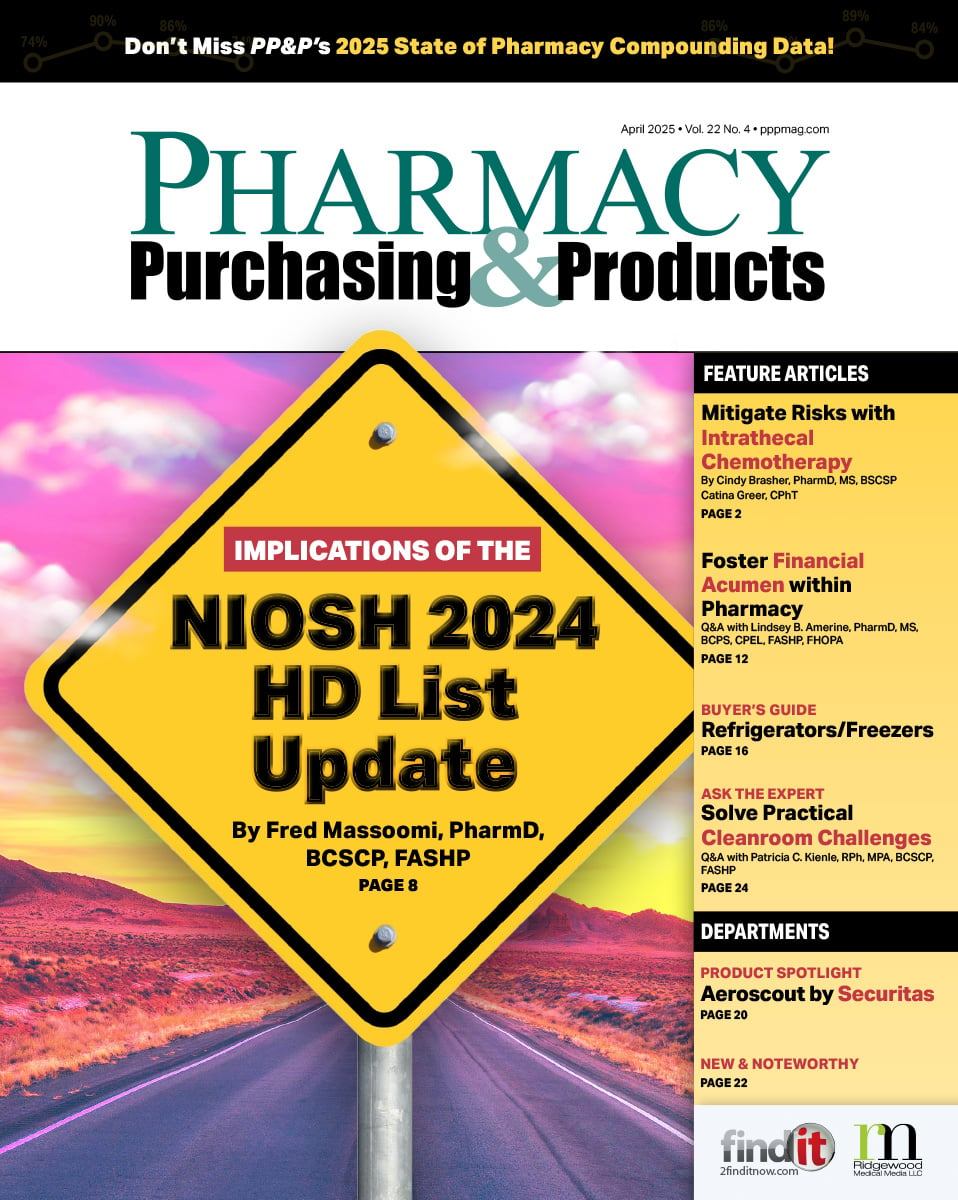- Show Menu
- Contact Us
- FAQs
- Reader Service
- Survey Data
- Survey Winners
- Testimonials
- Upcoming Events
- Webinars
- White Papers
Ask the Expert: How Can Pharmacy Maximize the Value of Wipe Analysis?
Pharmacy Purchasing & Products: What are the benefits of conducting regular wipe analysis?
Fred Massoomi, RPh, PharmD, FASHP: USP <800> recommends conducting surface sampling for hazardous drug (HD) residue routinely. The chapter goes on to define this as conducting an initial wipe analysis to establish a benchmark followed by additional wipe analyses that occur at least every 6 months or more as determined by the needs of the site. When a facility begins the process of redesigning and reconfiguring work spaces to meet USP <800> standards, the ideal time to conduct a wipe analysis is prior to any drugs being brought into the space, as this provides a true baseline. Thereafter, a well-defined, systematic program for routine sampling will assist in monitoring the staff’s diligence in following standard operating procedures (SOPs). Conducting a wipe analysis to identify any HD residue serves as a tool that can assist sites with validating their cleaning practices.
In a perfect world, every HD compounding area cleaning would be followed by a universal wipe test to confirm the surface is clean and ready for use. In lieu of such a perfect system, we rely on regular wipe analysis. This approach provides the information necessary to help minimize the transfer of residue from surface to surface, or from surface to products destined for patient administration.
For over 20 years, we have known that the residues of HDs lurk in the environments where they are handled. We also know that these residues can transfer throughout the line of handling—from the receipt of the drug at the loading dock to its final disposal. Without conducting an analysis, facilities are blindly assuming they are immune to this widely established pattern. According to CriticalPoint’s 2017 USP <800> Compliance Study, few hospitals conduct regular wipe analysis, and those that do sample a limited area (see FIGURES 1 and 2). Conducting regular wipe studies quantifies the site’s active risk, allowing the facility to either improve practices or praise staff for following well-defined SOPs.
PP&P: What are the considerations for purchasing a wipe kit?
Massoomi: Most of the commercially available wipe kits contain all the necessary supplies required to collect the sample (see FIGURE 3). However, the contents of each vendor’s kit will vary. Note in advance what supplemental equipment will be necessary, eg, properly sized personal protective equipment (PPE), shipping containers, etc. Note that the process of collecting HD sample residue(s) is a hazardous process in itself. It should be treated as a high-risk procedure and require the use of proper PPE for handling HDs. This is particularly important as the process of collecting a sample creates additional risk given the use of a liquid solvent to wet a defined space, which is then wiped to collect the sample. With an increased risk of splashes during this process, facilities may want to consider the addition of eye protection for staff collecting samples.
To start, an organization should compare its defined PPE program with the contents of third-party commercial wipe analysis kits (see TABLE 1). Take an inventory of the provided kit and supplement with any supplies necessary to conduct the analysis from start to finish. Key steps to consider during this review include: site preparation for sampling; documentation of sampling (disposable pens); labeling of samples; area zoning for sampling (adhesive dots, tape); PPE required for each sample (PPE that is fitted to the person(s) handling the collection and preparation processes); transfer containers to take samples out of the sampling zones (eg, resealable plastic baggies); shipping (shipping materials); and clean up (HD waste containers). Identifying any missing equipment once the sampling process has begun is too risky, as a break in the process can lead to lapses in safety.
PP&P: How should an organization ensure wipe sampling occurs at least every 6 months?
Massoomi: Facilities utilizing primary engineering controls (PECs) are required to have these units certified for proper functionality every 6 months. This is typically a pre-scheduled process and the third-party certifying company notifies the facility when certification is due. A simple process is to schedule the wipe sampling to coincide with the recertification process. Unlike certification of PECs and secondary engineering controls (SECs), where it is ideal to test during actual working conditions, wipe analysis should occur when no sterile compounding is taking place, and when traffic to the sampling area is limited.
In addition, consider adding a resampling step to validate the cleaning of any spills deemed significant. Keep in mind that the results will not be received for up to a few weeks; nonetheless, they will clearly demonstrate whether the cleaning process was sufficient.
Click here to see FIGURE 1 and FIGURE 2.
PP&P: What are the considerations for developing an organization-specific wipe sampling plan?
Massoomi: Randomly ordering a kit and conducting a wipe assessment one time versus developing a thoughtful wipe sampling plan will deliver significantly different results. Organizations should be clear as to their purpose for conducting the assessment and delineate how the data will be used over time. Likewise, it is key to develop a plan to relay this information to the frontline staff. When staff does not receive full disclosure of the program goals, it is easy for unsettling questions to arise, such as: Is my place of employment a hazard to me? or Am I being monitored because they suspect I am doing a poor job? The vacuum created by uncertainty is quickly filled with assumptions that can lead to a misunderstanding of well-laid plans from leadership.
Articulating a plan that is consistent with the facility’s SOPs and that serves to monitor and validate a critical process should be understood by staff as the goals of the formal wipe sampling program. It is equally important to emphasize that the process for handling HDs is not a precise science; expect that the practices in place today will evolve as experience is gained and technologies evolve.
PP&P: What challenges are associated with wipe sampling?
Massoomi: Organizations must understand that wipe sampling typically tests for a handful of specific HDs; the results do not represent all HDs. As such, non-detectable results from a specific analysis do not guarantee that no HD residue is present. Result assessment is further complicated by the fact that no standards exist for residue limits; however, the goal should be a zero tolerance of measurable residue(s). Ultimately, just as radiology staff would not consider working without leaded garments and personal dosimeters, neither should staff consider handling HDs without the protection of a regular wipe analysis program.
PP&P: What staff training should be provided?
Massoomi: Educating staff with regard to hazardous or critical processes must be consistent and continual. The education must serve to instill a culture of continuous safety, not only for pharmacy staff, but also for every individual involved in the HD handling process. It is the pharmacy director’s responsibility to ensure this occurs.
Compliance is generally assumed based on documentation. If it is documented, we can assume it occurred; conversely, if it is not documented, we can assume it did not occur. A two-pronged approach is necessary to ensure ongoing compliance: the employer is responsible for providing the means to measure compliance to the safety standards that protect employees, and the employees must understand and agree to uphold the compliance requirements.
PP&P: How can an organization develop a culture of safety to support a wipe sampling program?
Massoomi: As new equipment, new tests, new drugs, and published operational studies are made available to frontline staff, their input must be given priority in order to create collaborative opportunities to improve overall safety. Safety starts with the individuals at the greatest risk, with the leadership striving to provide staff with the tools necessary to ensure their safety. A recent study demonstrates that a leadership engaged with prioritizing staff safety has staff that demonstrates robust compliance with the use of protective measures.1
PP&P: How should an organization select agents for deactivation, decontamination, cleaning, and disinfecting?
Massoomi: USP <800> provides a four-step process for addressing HD residue and microbial contamination (www.usp.org/sites/default/files/usp/document/our-work/healthcare-quality-safety/general-chapter-800.pdf). Note that 70% isopropyl alcohol (IPA) as a lone agent does not address the deactivation, decontamination, and cleaning of HDs, let alone any type of drug residues. And if it is not sterile, 70% IPA is ineffective as a disinfecting agent.
Within the prescribed cleaning processes, USP issues a warning for the first step, deactivation, noting that There is no one proven method for deactivating all compounds; nonetheless, many organizations continue to blindly rely on just one or two agents to address this complicated process. Pharmacy directors and designated compounding personnel should demand published wipe studies of the commercial products. Triangulating published papers on given chemicals that deactivate certain drugs should not then be extrapolated as support for the use of a commercial product. Rather, supporting studies must be completed with the commercially available product in its current market-ready formulation(s).
Working with environmental services, infection control, and the cleaning agent vendors provides the best prospect for developing an effective four-step protocol for proper cleaning. Once the facility’s protocol is developed, it should be validated to demonstrate the expected results. Wipe studies can be utilized to help validate the cleaning process, albeit with an understanding of the current limitation from the lag in results.
PP&P: Should organizations request that CSTD vendors assume the cost for wipe analysis?
Massoomi: Wipe assessments are sometimes offered as a service by CSTD manufacturers, and in some instances may serve as a facility’s initial introduction to a measurable problem. Certainly this step demonstrates the manufacturers’ commitment to safety; however, unless the site is willing to invest in a thorough wipe sampling program, caution should be taken on reacting to the ramifications of a single assessment.
Consider that it would not make sense to ask the manufacturers of laminar flow workbenches to do surface sampling for viable particles with every workbench installation. We know that there are too many variables and processes beyond a single device in the cleanroom, and it would make no sense to analyze such data without looking at the whole process.
Ultimately, wipe analysis is not the responsibility of the CSTD manufacturers; it is the responsibility of the site engaged in compounding drugs for patients. The CSTD is only one component of many steps taken in the hospital to minimize HD residues. Should a facility conduct testing after CSTD implementation and the results are negative, does that data reflect the impact of the CSTD only, or does it reflect a change to procedures? Does that one moment in time truly reflect the ongoing use of any device used within the process? Developing a comprehensive HD safety program is the most effective way to protect staff and minimize HD exposure.
For more information about wipe analysis, see Fred Massoomi and Kelly L. Knolla’s previous PP&P article, Identifying Hazardous Drug Residue via Wipe Analysis, at www.pppmag.com/wipeanalysis.
Reference
- DeJoy DM, Smith TD, Woldu H, et al. Effects of organizational safety practices and perceived safety climate on PPE usage, engineering controls, and adverse events involving liquid antineoplastic drugs among nurses. J Occup Envir Hygiene. 2017;14(7):485-493.
 Fred Massoomi, RPh, PharmD, FASHP, is a senior director of hospital and health-system pharmacy for Visante, Inc. He received his doctorate from the University of Kansas School of Pharmacy. Fred is a member of PP&P’s Editorial Board.
Fred Massoomi, RPh, PharmD, FASHP, is a senior director of hospital and health-system pharmacy for Visante, Inc. He received his doctorate from the University of Kansas School of Pharmacy. Fred is a member of PP&P’s Editorial Board.
Like what you've read? Please log in or create a free account to enjoy more of what www.pppmag.com has to offer.








